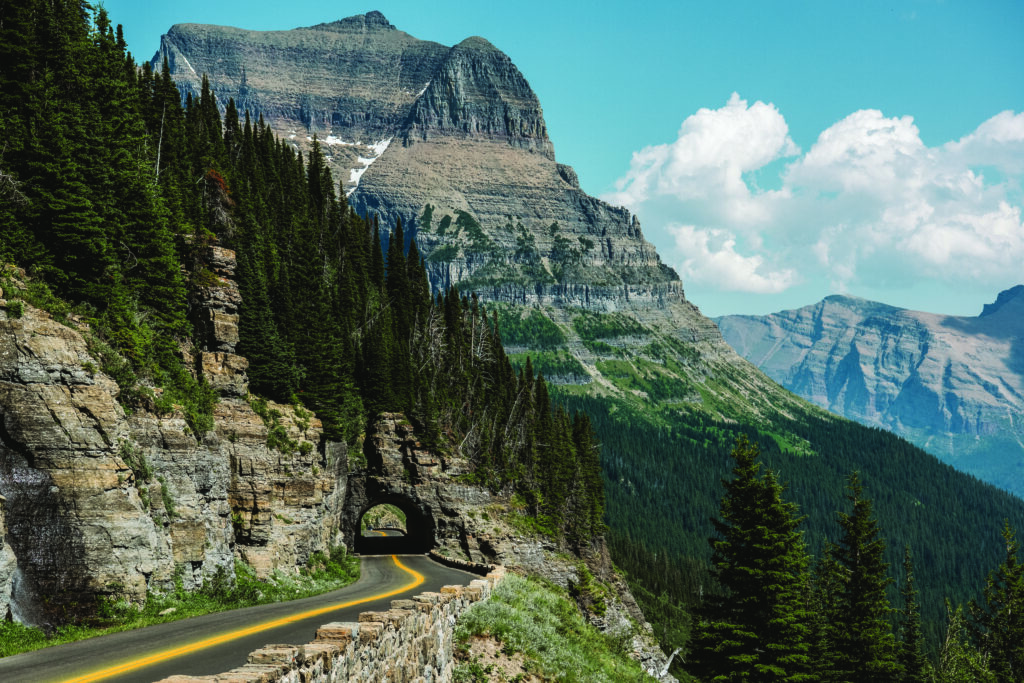The following snapshots showcase how money allocated within the Great American Outdoors Act was deployed to improve key infrastructure in our national parks.
To learn more about the Great American Outdoors Act and the future of our national parks, explore PERC’s report A Path Forward for America’s Best Idea: Lessons Learned for Our National Parks From the Great American Outdoors Act.

Going-to-the-Sun Road, Glacier National Park
One of the top attractions for the three million people who visit Glacier National Park each year is traversing the Continental Divide on Going-to-the-Sun Road. Completed in 1933, the feats of daring and engineering required to build the road included climbing 3,000 feet each morning to survey sites, carving a path from solid rock while navigating sheer cliffs, and dealing with short construction seasons and 60-foot snow drifts. It’s the only roadway that links the east and west sides of the park and is the primary route for visitors to enjoy scenic views of alpine forests and glacial lakes. A $26-million effort will rehabilitate nine miles of the road and replace an inadequate historic bridge. The project will improve geometry and alignment of the route, widen curves, help control traffic, and run fiber optic cable to park headquarters.
Tidal Basin, National Mall and Memorial Parks
Twice a day, the Tidal Basin in our nation’s capital absorbs 250 million gallons of high-tide waters from the Potomac River. Once the tide turns, water flushes out of the basin, taking with it silt and sediment and keeping the Washington Channel navigable. Originally built in the 1800s, the 10-foot deep, 107-acre pool also maintains water levels in the Lincoln Memorial Reflecting Pool through a pumping system. But the historic seawalls of the iconic basin are sinking, prompting a $113-million investment to rehabilitate them. The project will add 700 pilings to bolster the foundation of a new, sturdier concrete seawall to protect against future higher tides and storm surges. Workers plan to salvage and reuse historic materials wherever possible. The investment will address safety hazards, reduce future maintenance costs, and preserve famous landmarks, including the renowned Japanese cherry trees that blossom each spring.


Fort Yellowstone and Old Faithful Historic Housing, Yellowstone National Park
Some of the historic structures that house employees in Yellowstone date to the 1800s, and many of them have severely deteriorated. That includes 34 structures at the Fort Yellowstone complex near Mammoth Hot Springs, many of which suffer from failing roofs, foundations, windows, and other exterior components that risk water intrusion and pose safety hazards. Similarly, the Laurel Dormitory in the Old Faithful Inn Historic District requires rehabilitation to address outdated mechanical, electrical, and plumbing systems, all carried out on an active geothermal site. Approximately $43 million from the Legacy Restoration Fund will make the work possible. Overhauling and refurbishing structures as needed at both sites will provide safe, modern, quality housing for employees, part of a larger effort to replace and expand employee housing at the world’s oldest national park.
Transcanyon Waterline, Grand Canyon National Park
The vast majority of the roughly six million people who visit the Grand Canyon each year enter at the South Rim, where about 2,500 residents live year round. All of them rely on a 12.5-mile pipeline system that carries water from the North Rim, across the canyon, and up the rim’s south side. Unfortunately, the Transcanyon Waterline has had 85 major failures since 2010, disrupting park operations, forcing cancellations of visitors’ lodging reservations, and threatening locals’ water supply. Originally built in the 1960s, the waterline exceeded its anticipated 30-year lifespan long ago. A series of band-aid repairs over the years have often required helicopters to shuttle workers and supplies over rugged terrain to fix leaks, costing roughly $25,000 per repair. The Legacy Restoration Fund and revenues from park visitor fees are combining to fund more than $200 million to replace and rehabilitate the waterline as well as carry out other crucial utility work, securing the park’s water systems for the next half-century.


South Campground, Zion National Park
Zion National Park draws roughly five million visitors each year to its iconic pink and red sandstone cliffs, narrow slot canyons, world-class rock climbing, and diverse range of plants and animals. Visitation to the park has more than doubled in two decades, stretching maintenance capacity and overwhelming campground infrastructure. The South Campground is one of the park’s busiest, hosting 100,000 annual visitors and routinely hovering at 90 to 100 percent capacity. The site, which first hosted campers in the 1920s, has fallen into poor condition and is in need of work. Visitor fee receipts, disaster recovery funding, and $15 million from the Legacy Restoration Fund are combining to rehabilitate the campground to better serve visitors and ensure its functionality for the long term. The project will enhance 128 campsites, repave roads and vehicle pads, update bathrooms and drinking water systems, improve sewage and drainage systems, and more.
Water Treatment, Hawaii Volcanoes National Park
Virtually all of the potable water used by the roughly two million annual visitors to Hawaii Volcanoes National Park comes from a single source: rain. Historic structures that date to 1924 collect rainwater, which is processed through a series of sand filters and then treated to be safe for consumption. Overdue maintenance issues within the system, however, have increased the frequency of emergency repairs and risk the entire park’s water supply. Thanks to the Great American Outdoors Act, these issues are now being addressed. The project will replace roofs, siding, and gutters; make needed structural repairs; perform electrical and seismic upgrades to various components; and revamp water lines, storage tanks, and treatment processes. Nearly $34 million from the Legacy Restoration Fund will be used to rehabilitate the water treatment infrastructure, assuring a reliable and safe supply for the island park for years to come.



